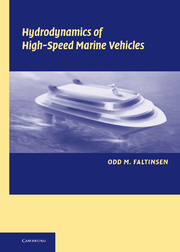Book contents
- Frontmatter
- Contents
- Preface
- List of symbols
- 1 INTRODUCTION
- 2 RESISTANCE AND PROPULSION
- 3 WAVES
- 4 WAVE RESISTANCE AND WASH
- 5 SURFACE EFFECT SHIPS
- 6 HYDROFOIL VESSELS AND FOIL THEORY
- 7 SEMI-DISPLACEMENT VESSELS
- 8 SLAMMING, WHIPPING, AND SPRINGING
- 9 PLANING VESSELS
- 10 MANEUVERING
- APPENDIX: Units of Measurement and Physical Constants
- References
- Index
3 - WAVES
Published online by Cambridge University Press: 15 September 2009
- Frontmatter
- Contents
- Preface
- List of symbols
- 1 INTRODUCTION
- 2 RESISTANCE AND PROPULSION
- 3 WAVES
- 4 WAVE RESISTANCE AND WASH
- 5 SURFACE EFFECT SHIPS
- 6 HYDROFOIL VESSELS AND FOIL THEORY
- 7 SEMI-DISPLACEMENT VESSELS
- 8 SLAMMING, WHIPPING, AND SPRINGING
- 9 PLANING VESSELS
- 10 MANEUVERING
- APPENDIX: Units of Measurement and Physical Constants
- References
- Index
Summary
Introduction
Before we can describe wave resistance in detail, we need to introduce wave theory. This theory is also needed in the description of wave-induced motions and loads on a high-speed vessel. We first present linear wave theory in regular harmonic waves in deep and finite water depths. This includes analysis of wave refraction. An irregular sea state can be represented as a sum of regular waves of different frequencies and wave propagation directions. Recommended wave spectra that describe the frequency content in irregular waves are then given.
Linear wave theory assumes that the wave slope is asymptotically small. Not all waves occurring in reality can be described by linear wave theory; an extreme example is breaking waves. Figure 3.1 illustrates plunging, breaking waves generated in a wave flume. We see breaking waves on a beach, but they can also occur in the open sea in deep water. A strong current in the opposite direction of the wave propagation steepens the waves. This is a phenomenon known in connection with the Agulhas current off the east coast of Africa. A typical feature of a nonlinear wave is that the vertical distance between the wave crest and the mean water level is larger than the distance between the mean water level and the wave trough.
Scatter diagrams of significant wave heights and mean wave periods are needed in operational and design studies. These diagrams describe the probability of occurrence of different sea states for a given operational area.
- Type
- Chapter
- Information
- Hydrodynamics of High-Speed Marine Vehicles , pp. 78 - 98Publisher: Cambridge University PressPrint publication year: 2006



